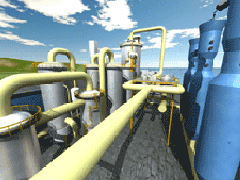 The North Sea is emerging as a center of development of carbon capture and storage technology, and it's not just because of the region's tightening regulation of greenhouse gases. The main attraction is the North Sea's rapidly-maturing offshore oil reservoirs, which offer both a place to store carbon dioxide from fossil-fueled power plants and an opportunity to use it to increase oil extraction. Oil production is slowing as many of the North Sea wells mature, and carbon dioxide pumped down the hole can loosen up and release the remaining oil.
The North Sea is emerging as a center of development of carbon capture and storage technology, and it's not just because of the region's tightening regulation of greenhouse gases. The main attraction is the North Sea's rapidly-maturing offshore oil reservoirs, which offer both a place to store carbon dioxide from fossil-fueled power plants and an opportunity to use it to increase oil extraction. Oil production is slowing as many of the North Sea wells mature, and carbon dioxide pumped down the hole can loosen up and release the remaining oil.
Several oil giants, including BP, Shell and Norway's Statoil, recently announced plans to build new power plants designed to convert North Sea natural gas into hydrogen, burn the hydrogen to produce electricity, and ship the resulting carbon dioxide to offshore oil wells. BP expects to produce an extra 40 million barrels of oil as a result of its plant between 2010 when the plant starts and 2030.
Meanwhile, an Oslo-based startup, Sargas SA, has secured industrial backers to build a coal-fired power plant in Norway using a new technology called pressurized combustion that co-produces power and carbon dioxide; it plans to sell its CO2 to offshore drilling sites. Before that, Sargas hopes to begin building a smaller plant early in 2007 that could be the prototype for offshore platforms producing power and CO2 where they're needed most: out in the North Sea oil fields.
"There is a real economic driver for the use of the CO2 for enhance oil recovery," says MIT process design expert Gregory McRae, who is tracking developments in carbon capture. "Its an incredibly exciting time."
Using industrial CO2 to enhance oil recovery could squeeze an extra 7.3 billion barrels of oil from the North Sea and simultaneously stow away 10 billion metric tons ofcarbon dioxide, according to a December 2005 study by the European Commission's Institute for Energy. The latter is the equivalent of stopping Europe's greenhouse gases releases for two and a half years.
What is holding up full development of the use of carbon dioxide for enhancing oil recovery is, ironically, a dearth of CO2. Dozens of natural gas and coal-fired power plants ringing the North Sea produce plenty, but capturing it is expensive because the CO2 in the flue gas is at very low pressure and concentration (most of the exhaust from a conventional planet is actually nitrogen gas carried through from the air used to fire the fuel). Carbon capture is estimated to add a 30 percent to 50 percent premium to the cost of producing electricity.
BP, Shell and Statoil's solution to the problem is a new plant design. Instead of just burning natural gas, the plants will use a chemical process called reforming to convert the fuel into concentrated streams of pure hydrogen and CO2. The hydrogen will be burned to produce electricity, while the CO2 would be pressurized and sent by pipeline to offshore oil platforms to be pumped into the hydrocarbon reservoirs below.
Sargas seeks instead to make the capture of carbon dioxide more efficient by cranking up the pressure. Its plants would burn gas or coal at high pressures, thus yielding a high-pressure exhaust in which the CO2 pressure is about 20 times higher than in a conventional coal plant. That pressure makes separating the CO2 from nitrogen and left-over oxygen in the exhaust far less costly.
Last week a consortium of companies in Norway including aluminum giant Alcan (a major power consumer) and Norwegian energy firm Norsk Hydro announced plans to build a 400-megawatt coal-fired power plant using Sargas' design; startup is targeted for 2011. Dale Simbeck, vice president of technology for Mountain View, CA-based energy consultancy SFA Pacific, calls it a "clever scheme" because coal is relatively cheap, while the high pressure system will help contain the cost of capturing the CO2. "What they're doing can make sense," says Simbeck.
Tor Christensen of Sargas says the company is working with a major United States-based oil and gas producer to exploit another feature of high-pressure combustion: the system's compact design. For a given power output Sargas' generators handle a volume of gas 40-50 times smaller than would a conventional plant. As a result the equipment is more compact—compact enough to put a 100-megawatt natural gas-fired plant on an offshore platform. "It's not much for an offshore platform," says Christensen of the 5,000 metric ton design. "A single crane can lift the whole thing."
McRae says the idea should be attractive for oil and gas producers. For one thing, Sargas' plants will capture CO2 on-site, eliminating the need to ship CO2 from shore. For another, they will serve the platform's power needs better than the diesel generators and relatively small gas turbines used today. "One of the big problems with offshore oil platforms is the power supply that you need to pump the oil and process the gas that comes out the ground. Sargas will allow you to get much larger power in a smaller space," says McRae.
Christensen says Sargas' goal is to deliver CO2 to oil platforms at roughly $20 per metric ton and, as a rule of thumb, each metric ton of CO2 should yield two or three extra barrels of oil. If oil prices stay high, says Christensen, "there's a tremendous amount of money to be made."
Source : Technology Review
Commentaires